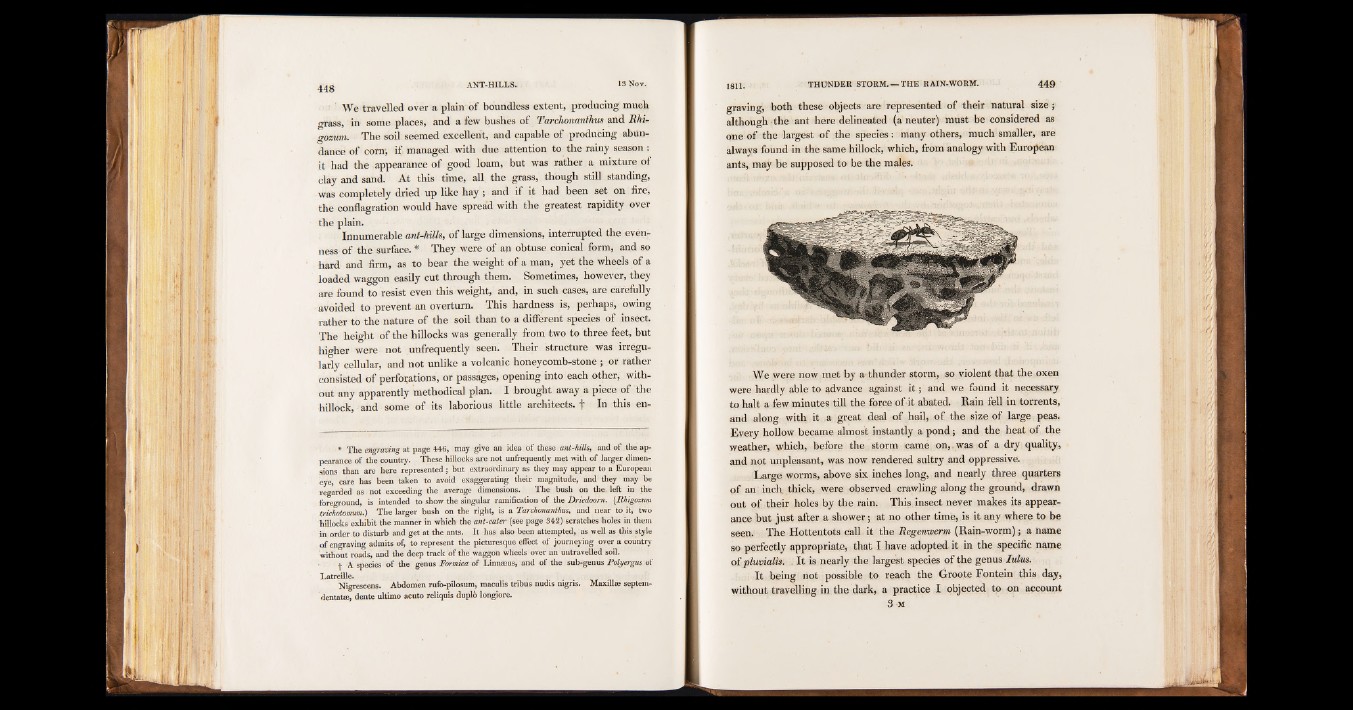
We travelled over a plain of boundless extent, producing much
crrass, in some places, and a few bushes of Tarchonanthw and Rhi-
gozum. The soil seemed excellent, and capable of producing abundance
of corn; if managed with due attention to the rainy season :
it had the appearance of good loam, but was rather a mixture of
clay and sand. At this time, all the grass, though still standing,
was completely dried up like h ay ; and if it had been set on lire,
the conflagration would have spread with the greatest rapidity over
the plain.
Innumerable ant-hills, of large dimensions, interrupted the evenness
of the surface. * They were of ap obtuse conical form, and so
hard and firm, as to bear the weight of a man, yet the wheels of a
loaded waggon easily cut through them. Sometimes, however, they
are found to resist even this weight, and, in such cases, are carefully
avoided to prevent an overturn. This hardness is, perhaps, owing
rather to the nature of the soil than to a different species of insect.
The height of the hillocks was generally from two to three feet, but
higher were not unfrequently seen. Their structure was irregularly
cellular, and not unlike a volcanic honeycomb-stone; or rather
consisted of perforations, or passages, opening into each other, without
any apparently methodical plan. I brought away a piece of the
hillock, and some of its laborious little architects, f In this en*
The engraving at page 446, may give an idea of these ant-hills, and of the appearance
of the country. These hillocks are not unfrequently met with of larger dimensions
than are here represented ; but extraordinary as they may appear to a European
eye, care has been taken to avoid exaggerating their magnitude, and they may be
regarded as not exceeding the average dimensions. The bush on the. left in the
foreground, is intended to show the singular ramification of the Drieioom. (Rhigozum
trichotomum.) The larger bush on the right, is a Tarchonanthus, and near to it, two
hillocks exhibit the manner in which the ant-eater (see page 342) scratches holes in them
in order to disturb and get at the ants. I t has also been attempted, as well as this style
of engraving admits of, to represent the picturesque effect of journeying over a country
without roads, and the deep track of the waggon wheels over an uutravelled soil.
f A species of the genus Formica of Linnams, and of the snb-genus Polyergus of
Latreille. _ . . . ' V ;
Nigrescens. Abdomen rufo-pilosum, maculis tribus nudis nigris. Maxilla- septem-
dentatse, dente ultimo acuto reliquis duplo longiore.
graving, both these objects are represented of their natural size ;
although the ant here delineated (a neuter) must be considered as
one of the largest of the species: many others, much smaller, are
always found in the same hillock, which, from analogy with European
ants, may be supposed to be the males.
We were now met by a-thunder storm, so violent that the oxen
were hardly able to advance against i t ; and we found it necessary
to halt a few minutes till the force of-it abated. Rain fell in torrents,
and along with it a great deal of hail, of the size of large peas.
Every hollow became almost instantly a pond; and the heat of the
weather, which, before the storm came on,, was of a dry quality,
and not unpleasant, was now rendered sultry and oppressive.
Large worms, above six inches long, and nearly three quarters
of an inch, thick, were observed crawling along the ground, drawn
out of their holes by the rain. This insect never makes its appearance
but just after a shower; at no other time, is it any where to be
seen. The Hottentots call it the Regenwerm (Rain-worm); a name
so perfectly appropriate, that I have adopted it in the specific name
of pluvialis. . It is nearly the largest species of the genus lulus.
It being not possible to reach the Groote Fontein this day,
without travelling in the dark, a practice I objected to on account
3 M